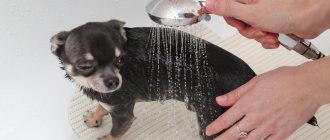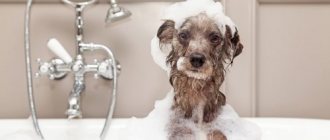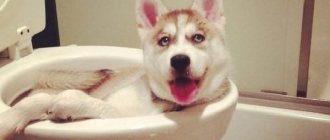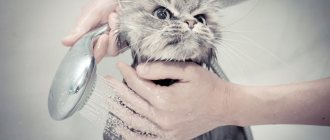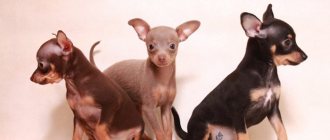How to take care of someone who needs you!
Baby Kerry - “Oh, those mischievous eyes...” - Go to the photo album page
So, your family has been expanded with a little friend. Now you have a small dog - a Russian toy terrier. And of course, your first concern is how to properly care for your beloved toy or cat. Grooming a small dog is not very difficult (with the possible exception of Yorkies), but it still requires certain skills and knowledge. Let's look at everything in detail.
Bathing
Bathing the Russian Toy Terrier should occur as soon as it gets dirty. There is no need to bathe your baby every day; you can limit yourself to washing your paws after a walk in the fresh air. It should be taken into account that frequent water procedures can dry out the dog’s skin and lead to dandruff. It is better to bathe a toy terrier using special products designed for bathing dogs in warm water. The fact is that a dog’s body temperature is about 1 degree higher than a human’s, so in cold water the toy can freeze. When bathing, it is better to cover your toy terrier's ears with cotton swabs to prevent water from entering.
Note: When using flea drops that are applied to the dog’s withers, you should postpone bathing the toy terrier for two days from the date of application of the drops. The fact is that over these days the effect of the drug gains strength and reaches the concentration necessary to protect the dog.
Frequency of Toy Terrier bathing
Most veterinarians and owners of this breed believe that the Russian Toy Terrier should be thoroughly bathed once every six months . This is the most correct guess. Some breeders recommend bathing adult dogs every few weeks, or conversely, washing your pet no more than a few times in its entire life. But the dog should wash much less often, depending on the dirt. The optimal frequency is no more than once every five months.
Before bathing your Russian Toy Terrier, you need to check the temperature level of the water. In this case, the temperature suitable for the dog is 39-43 degrees.
Nail care
It is imperative to trim your toy terrier's nails, otherwise the dog will place its paws incorrectly, which can lead to bending of the limbs. Nails are trimmed as needed.
To understand exactly where to trim the claw, you need to take the dog’s paw in your hand and look at the claw from the side. In the place where the claw begins to bend down, you need to cut.
Practical advice: In order for a small dog to tolerate nail trimming more calmly, you can encourage it with a treat. The toy terrier, receiving a treat after each cut claw, will quickly understand that the unpleasant procedure is rewarded with something tasty, and it is easier to endure it and receive a reward than to growl and break out of the owner’s hands.
Caring for the claws of the Russian Toy Terrier.
“Is it necessary to trim the nails of a Russian Toy Terrier? Or can this procedure be avoided?
Answer: It is necessary to trim your toy’s claws. If this is not done, the dog will place its paws incorrectly, which can lead to bending of the limbs.
“How often should a toy’s nails be trimmed?”
Answer: The claws of the Russian Toy Terrier are trimmed as needed. As a rule, this happens approximately once or twice every two weeks, depending on the individual characteristics of your pet.
“Please tell me how to properly trim the claws of a Russian toy?”
Answer: Sit comfortably, place your Toy on your lap, take the Russian Toy's paw in your hand and lightly press his paw to better see his claws. Look at the side of the nail. In the place where the claw begins to bend down, you need to carefully cut it off using a special nail clipper, which can be purchased at a specialty store. If you doubt your abilities, you can entrust the nail trimming procedure to a professional groomer.
Ear care
Of course, the Russian Toy's ears need to be cleaned if wax discharge is visible. It is best to use cotton swabs, gently and shallowly cleaning the ears.
Owners of a small dog are often concerned about the question: “What to do if the toy terrier’s ears don’t stand up?” The answer is simple: massage and sizing of the ears.
The massage is performed every day with two fingers from the base in the center and up. Give the procedure enough attention and time. The problem of weak ear cartilage will also be solved by timely and correct sizing. This procedure can be done at home. You will need:
- Medical very sticky plaster approximately 2 cm wide;
- Scissors;
- An ear splint, which can be made from any thin, hard, long object (the base of a cotton swab, for example);
- Degreasing lotion.
First, you should wipe the inside of the toy's ear with lotion (so that the patch sticks firmly and does not come off). Any lotion for degreasing the skin will do. Next we make the base for gluing. Take a splint (the base of a cotton swab, a piece of the rod from a pen, etc.), cut off two pieces of adhesive tape with rounded ends. We lay a tire between them and glue them together. Next, cut a piece of the patch the width and length of the toy terrier’s ear, but wider and longer than the blank with the splint. Using a piece of plaster, glue the blank with the splint to the ear of the toy terrier. This simple procedure will help to avoid creases in the ears of a small dog and will help them grow in time.
Caring for the ears of a toy terrier.
“Are there any rules for caring for a toy terrier’s ears?”
Answer: The ears of decorative dogs of the Russian Toy breed need to be cleaned if any wax discharge is visible. It is ideal to clean the ears with a special product purchased at a pet store. To do this, you need to drop a few drops of the product, heated to room temperature, into the ear of the baby, wait until the product spills, and then carefully roll it shallowly in the ear with a cotton ball. If you don’t have a special product, you can clean the toy’s ear with cotton swabs. Be careful not to go deep into the burrow and only use cotton swabs that have a tightly sealed cotton head.
“What should you do if water gets into your toy’s ear?”
Answer: Of course, it is advisable that during bathing water does not get into the Russian Toy Terrier’s ear at all. To do this, use cotton balls or swabs to close the ear to prevent moisture from getting inside. If trouble does occur, blot your ear with a dry cloth and use a cotton ball. If water has flowed deep into the ear, place the toy on your lap with the ear with the water down and lightly shake its head. If this procedure does not help, carefully insert a cotton swab into the dog’s ear, wait until the moisture is absorbed, then repeat the procedure with a dry cotton swab until all the water comes out of the dog’s ear. Do not leave a small dog in a draft: it can cause inflammation of the middle ear.
“My Russian Toy Terrier puppy’s ears are not getting any better. Is there anything I can do to help him?
Answer: The problem of weak ear cartilage can be solved with daily massage and timely sizing. You can carry out sizing at home. To do this, you will need a sticky medical plaster 2cm wide, scissors, an ear splint, and degreasing lotion. First you need to make a tire. To do this, we need something like a tube (it could be a piece of a ballpoint pen, a stick from which a cotton head was removed, etc.). We cut the tube to the size of the toy's ear and place it between two pieces of plaster with rounded edges, also cut along the length of the toy's ear. Having degreased the Russian Toy Terrier's ear, we glue our splint to the ear using another piece of plaster, cut to the size and shape of our pet's ear. Except for gluing. It is advisable to massage your toy's ears: with two fingers from the base of the ear to the center and up. Massage should be done every day.
Dental care
Grooming a Russian Toy Terrier includes mandatory systematic dental care. The Toy Terrier's teeth must be periodically brushed or special biscuits used to prevent the formation of tartar. The frequency of teeth cleaning depends on the composition of the saliva and the diet of the small dog. If tartar has nevertheless reached your pet’s teeth, you should contact an experienced veterinarian who will save your dog from this problem.
Another important point in caring for a small dog’s teeth is the removal of baby teeth. Unlike the teeth of large dogs, the canines of toy terriers do not fall out on their own because their roots do not dissolve. This necessitates the removal of the Toy Terrier's teeth.
Many owners of small dogs entrust the solution to this problem of caring for their terrier to veterinary clinics. However, these establishments often use unacceptably large doses of anesthesia when removing milk teeth for dogs, which leads to health problems for the animals. It is possible to remove the milk teeth of a Russian Toy yourself at home. For this you will need:
- Any mounting side cutters that you can buy in a store with sharp short jaws;
- Gauze tampons;
- Lidocaine or novocaine 2%;
- A steady hand and courage.
Process:
- The terrier's milk teeth are removed only when hints of molars appear - white tubercles on the gums, which indicate that several days will pass and molars will appear in these places.
If you remove baby teeth before the molar cusps appear, you can ruin your dog's bite. Practical advice: The lower canines of Toy Terriers erupt from the inside of the lower dentition, therefore, in order not to miss their eruption, you need to look under the dog’s tongue more often when changing teeth. - When using side cutters, make sure that the handles are insulated and do not slip in your hands.
- Before removing a tooth, soak a gauze swab in lidocaine or novocaine and apply it to the dog’s gum for a few minutes. This will numb the site of tooth extraction.
- You need to break off the tooth with a sharp, precise movement right under the gum so that nothing protrudes from under the gum. If you are unable to completely break out the fang the first time, repeat the procedure. Try not to hit the gum, but if you do and you see a little blood, don't panic. Apply a sterile gauze pad and stop the bleeding.
The advantage of home removal of fangs is the absence of anesthesia, which has a harmful effect on the toy terrier’s body, as well as the avoidance of root canine removal, which causes excessive bleeding.
Caring for the Russian Toy's teeth.
“Why do some small dogs have no tartar, while others have it as a constant problem?”
Answer: All small dogs are susceptible to tartar. However, the frequency of brushing your teeth against this scourge really differs from one toy to another. It depends on the enzymatic composition of saliva and diet, as well as preventive measures taken by the owner to prevent the appearance of tartar.
“How to recognize tartar? Is it possible to rid a Toy of it at home?”
Answer: Tartar is a hard yellowish coating that appears on the teeth of a toy, especially in places of contact with the gums. Unfortunately, it is impossible to get rid of it at home. This procedure must be carried out in a specialized veterinary hospital by a professional veterinarian.
“What preventive measures should be taken and how to care for the teeth of a Russian Toy Terrier in order to protect his teeth from tartar?”
Answer: To prevent the formation of tartar, it is necessary to brush your small dog's teeth regularly. You need to take a cotton or gauze swab, apply toothpaste to it and, opening the dog’s mouth, carefully treat the teeth and gums, especially in those places where they come into contact with each other. After this, wash off the toothpaste. This can be done using a spray bottle or a damp cloth. In addition to brushing teeth, special biscuits and bovine skin bones, which can be freely purchased at any pet store, are used to prevent tartar in dogs.
Other recommendations
In addition to the advice we have already given, let me make a few additions that are undoubtedly important:
- Do not take your dog out for a walk while wearing a harness. This causes the Toy Terrier's joints to form incorrectly.
- Never leave your dog alone near a store or in a car.
- If you have any doubts about your dog's health, contact your veterinarian immediately. It’s better to play it safe than to bite your elbows later because of lost time.
Reading the recommendations described above, it may seem that caring for a Russian Toy Terrier is complex and requires special skills and knowledge. We assure you, this is absolutely not true! Of course, certain knowledge and skills are needed, but they are simply acquired through experience. Believe me, after just a couple of weeks, caring for your toy will give you great pleasure.
It’s so nice to take care of someone who needs you, and in return is ready to give love and selfless devotion!
return to section
How often should you bathe your dog?
Many veterinarians and dog breeders are of the opinion that it is enough to wash a toy terrier once every six months . Most likely, this point of view is correct. Of course, on the Internet you can find recommendations to bathe your toy terrier every two weeks or, conversely, give your pet a bath no more than two or three times in its entire life. It seems to us that such recommendations are extremes, and the optimal frequency of bathing that should be followed is once every five to seven months.
Attention!
You should not wash your dog for fourteen days after it has received any vaccinations.
The water intended for bathing the toy should be warm enough, but not hot. The most suitable temperature is 40 degrees.
Ear and eye care
A toy terrier's ears need to be cleaned at least once a week. This can be done with a special product designed for cleaning ears, or camphor alcohol.
You need to apply the product to a cotton swab and clean the surface of the ears from dirt. You can penetrate no more than half a centimeter inside.
If any discharge appears from the ears, contact your veterinarian.
When bathing, you should cover your toy terrier's ears with cotton swabs.
It is important to accustom your pet to daily washing - this is the basic principle of caring for a dog’s eyes.
You can wash your eyes with boiled water or chamomile decoction. All discharge from the eyes must be removed.
After the procedure, you should blot your eyes with a dry cloth.
